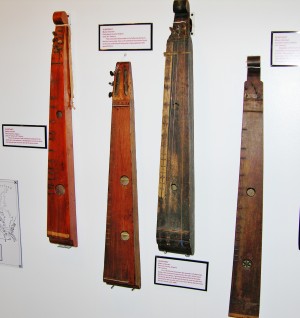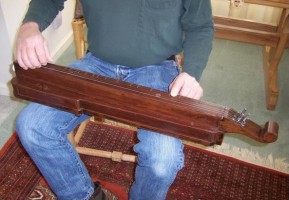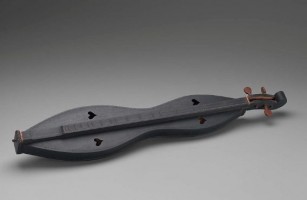Dulcimer Ancestors
![]()
The Appalachian, Lap or Mountain Dulcimer – as we know it today – is a comparatively modern instrument, although its precise development is still the subject of intense debate.
As a member of the fretted zither family, its origins go back a long way. Similar instruments are found across much of northern Europe: the epinette des Vosges in France; the hommel or hummel in Belgium, Flanders and the Netherlands; the scheitholt in Germany; the langeleik in Norway; and the langspil in Iceland. Notice that there is no record of any similar instrument in the British Isles! The eminent European musicologist Wilfried Ulrich prefers the generic term “hummel” for dulcimer ancestors native to northern Europe. He has found references to the hummel from the early 16th century and surviving instruments from the 17th century – one discovered encased in an ornate plaster ceiling as recently as Autumn 2013.

Although these are all melody/drone, diatonic instruments like the original dulcimer – 1 or 2 fretted melody strings and up to 10 or more drone strings – most are box-shaped and all have a shallow fretboard attached directly to the body. Current thinking is that the northern European settlers to America of the late 18th and early 19th century brought a memory of these instruments with them – perhaps even actual instruments. When they settled the then-remote Appalachian states, they wanted instruments to entertain themselves and started building simple versions of fiddles, hummels and banjos with the materials to hand.
US instruments from the 19th century have been found which are clearly still box-like hummels (see left). Yet there are others, from later in the century, which are clearly dulcimers – more rounded, with a raised, fretted fingerboard. There are others (see below) which are possibly a transitional instrument, with a small boxy hummel and fretboard mounted directly on a rounder dulcimer-type body (rather like the modern concert epinette des Vosges). Why and how this development occurred, however, is unclear and it seems unlikely that there was a straightforward linear progression from one type to the other.
 The name “dulcimer”, attached to a small instrument for making music in the home, has been found in US family histories from the 1830s. However, it is unlikely they were ever a common sight. Cecil Sharp, the great British song collector, who visited the southern Appalachians in 1916, describes one almost as a curiosity: “In Kentucky…singers occasionally play an instrument called the dulcimer, a shallow, wooden box, with four sound-holes, in shape somewhat like a flat, elongated violin, over which are strung three (sometimes four) metal strings, the two (or three) lower of which are tonic-drones, the melody being played upon the remaining and uppermost string which is fretted.”
The name “dulcimer”, attached to a small instrument for making music in the home, has been found in US family histories from the 1830s. However, it is unlikely they were ever a common sight. Cecil Sharp, the great British song collector, who visited the southern Appalachians in 1916, describes one almost as a curiosity: “In Kentucky…singers occasionally play an instrument called the dulcimer, a shallow, wooden box, with four sound-holes, in shape somewhat like a flat, elongated violin, over which are strung three (sometimes four) metal strings, the two (or three) lower of which are tonic-drones, the melody being played upon the remaining and uppermost string which is fretted.”
For the first half of the 20th century, the dulcimer stayed in the mountains, with the knowledge of its construction being passed on by itinerant makers who moved from one remote rural community to the next. A good example is “Uncle” Ed Thomas (1850–1933) who passed his designs – for a price – to Jethro Amburgey (1895–1971). A 1913 example of Thomas’ dulcimers from the Museum of Fine Art in Boston is shown below. For more details of the link between Thomas and later makers, see the description of an Amburgey dulcimer in the Gallery section. Pleasing shapes were traced, viable fret patterns copied and the secrets of louder or sweeter sound identified. The rural settlement schools were a particular focus for the spread of dulcimer making. These charitably-funded centres provided education, health care and social services in what was then one of the poorest areas of the country. But they also placed great emphasis on rural  crafts, on preserving and developing the traditional art forms of the communities they served. Graduates of these colleges included dulcimer builders like Amburgey, John Tignor, Jess Patterson and Homer Ledford. Rural crafts were also promoted through the Craft Guilds, which provided opportunities for makers to learn from each other and sell their wares at well attended shows. Edd Presnell and John Maxwell, amongst many others, were able to launch their careers and begin to earn a living from building dulcimers in this way.
crafts, on preserving and developing the traditional art forms of the communities they served. Graduates of these colleges included dulcimer builders like Amburgey, John Tignor, Jess Patterson and Homer Ledford. Rural crafts were also promoted through the Craft Guilds, which provided opportunities for makers to learn from each other and sell their wares at well attended shows. Edd Presnell and John Maxwell, amongst many others, were able to launch their careers and begin to earn a living from building dulcimers in this way.
Instruments from this simple, rural craft tradition suited the principles of the early folk revival of the 1950s and 60s – as well as the playing style of the dulcimer’s greatest early exponent, Jean Ritchie of Viper, Kentucky. By the late 60s and early 70s, however, the folk movement had broadened considerably and the playing styles of new stars like Joni Mitchell, Richard Farina, Robert Force and Albert d’Ossché and Leo Kretzner were very different. On the west coast in particular, dulcimers were being built in much the same way as guitars, in batches by small teams in workshops – and borrowing guitar frets, intonation, tuning pegs and construction methods. Names such as Capritaurus, Rugg and Jackel (later FolkRoots), Dulcimer Works and Magic Mountain emerged and achieved wide popularity. Elsewhere, similar establishments were formed to meet the booming demand for dulcimers – names which are still familiar today such as McSpadden in Arkansas and Folkcraft in Vermont (later Winsted, Connecticut).
So instruments from the 70s and 80s fall into two camps: those rooted in the tradition, with hand-cut wooden pegs and meantone intonation; and more modern-style instruments with full width frets, equal temperament and guitar/banjo mechanical tuners. Many of those opting for the former were consciously buying into a nostalgic rural past – a beautifully crafted artefact from a supposedly simpler place and time, often for display as much as for play.
In the last 20 years, the worldwide demand for dulcimers has fallen. The biggest market, the US, continues to be served by a few small workshops, producing instruments under well-known brands such as McSpadden, Folkcraft, Black Mountain or Cedar Creek. Individual makers also continue to produce high quality instruments: some in the traditional style, like Warren A May of Berea, Kentucky; others in unusual and adventurous ways, such as Bob and Janita Baker (Blue Lion) in California, Ron Ewing in Ohio, or David McKinney (Modern Mountain) in Arkansas. Unfortunately, the majority of purchases are still of mass-produced instruments from low wage economies in eastern Europe or the far east – which rarely do the instrument justice and which continue to discourage many aspiring players.

